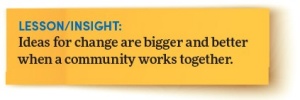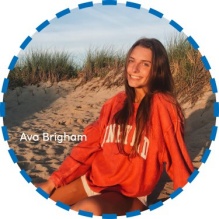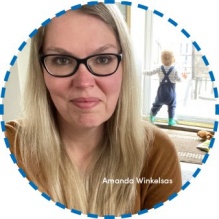
Ground-breaking collaboration with teens from across Western New York sparks new ideas for school reform
BY MICHELLE KEARNS
It was 30 minutes into the very first meeting of teenagers from across Western New York. Students were typing their thoughts about school reform and change on bright yellow, orange and pink virtual sticky notes. The cyber bulletin board on the Zoom call was filling up with their ideas about school change.
“A place where mental health is not just focused on but actually taught about to students and staff.”
“An open environment where you can express your feelings.”
“My ideal school would be less stressful.”
“Teachers making sure everyone understands what’s happening instead of rushing to do tests.”
These suggestions came during the inaugural gathering of the Western New York Youth Alliance for Education, a GSE initiative that brought together teens during a chaotic time so they could make their ideas known, discuss what was important to them and learn how to advocate for change. As the first session unfolded, students were surprised by how good it felt to discuss new ideas. The GSE-guided project, with eight local community collaborators, aims to cultivate students’ ideas about equity in education and help them to organize.

“What they want to do for kids is incredible,” said Lily Fisher, 14, an eighth grader at Sweet Home Middle School in Amherst. “I think this is a fantastic program. The way that it’s unfolding is extraordinary. They’re giving us a voice. The adults aren’t running it."
So far, the group, known as YAE, pronounced “yay,” has drawn about 100 students in grades 7-12 from 23 schools across Western New York. Students met and identified priorities that subcommittees are now working on: Anti-racism and cultural diversity, mental health services, anti-bullying and safer schools, improving student-teacher interactions and a more inclusive LGBTQIA+ environment.

“By the end of it, I was just feeling so much hope for what we could do with this organization,” said Jillian Farrell, a GSE graduate student working on her master’s degree in higher education and student affairs. She has been surprised by the students’ innovative suggestions, curiosity and passion for finding ways to include all kinds of student perspectives in school decision making.
“I feel like I’ve really expanded the way I think about higher education,” she said.
From the start, Farrell was impressed by students’ ideas for school change as she read their YAE applications—from creating resource groups for students with mental health concerns to reducing waste by using washable metal silverware instead of plastic.
“Every single one of them had amazing things to say,” said Farrell. “I lucked out that this is the project that was put in my lap.”
The experience has broadened her own career interests. She enrolled at GSE during the pandemic because of the strength of its higher-education training and her ambition to coordinate college study-abroad programs. Now, Farrell realizes she enjoys working with junior high and high school students. She likes helping them advocate for things like LGBTQIA+ concerns and getting faculty to use preferred pronouns.
“They just want to help out the students that need it,” said Farrell. “They’re all fighting for everyone else in their schools.”
YAE meetings, which are open to any junior high or high school student in the region, will continue on Zoom for the time being but, eventually, they will include in-person gatherings.
For now, the virtual format has yielded impressive results. Farrell has admired the consideration and camaraderie she’s noticed as students use the Zoom chat function to praise each other for good ideas.
“They’re so excited to be a part of something. To be so loving to each other,” said Farrell. “That’s something that amazed me from the get-go.”
Ideas in action

From the beginning, Ava Brigham, 16, was so interested in exploring the ideas that came up, like student support groups, she decided to start up a related organization at her own school in Royalton-Harland High School in Middleport.
She won approval from the superintendent to start Students for Tolerance Unity Diversity and Inclusion, or STUDI, a club focused on creating awareness and understanding. “Its purpose is to normalize these things that are going on in the world,” said Brigham. Because her school is not racially diverse, a group of about 10 or 20 students starting to meet every other week began by researching and discussing pandemic-era civil rights protests.
“The topic that we’re focused on right now is the Black Lives Matter Movement,” she said. “People had a lot of good questions because they had never thought about learning about it before.”
YAE also taught her about process. As Brigham plans, she is applying the SMART goal model she learned and is making sure aims are smart, measurable, achievable, realistic and timely.
So far, she said, YAE has been eye-opening.
“I love how thoughtful and intelligent everyone in the group is,” she wrote in a survey, “and hearing their different opinions regarding problems in their schools is very interesting and inspiring. I have never been included in anything like this group, so it’s super exciting.”
For the GSE faculty leader organizing YAE, the experience has been energizing.

“The kids truly see themselves as change agents, which is exactly what we were hoping to foster,” said Amanda Winkelsas, assistant dean for outreach and community engagement and a clinical assistant professor of learning and instruction. “The experience of participating is validating that expertise and fostering that sense of agency in students, which ultimately will make for better, more equitable schools.”
The project began to develop last summer during conversations with GSE Dean Suzanne Rosenblith. The pair talked about the social justice protests of the pandemic. As they considered Buffalo’s own segregated school system, they wanted to bring students together to share their perspectives about achieving racial equity.
“The idea is that kids are the experts on their own experiences and have important things to say,” said Winkelsas. “How do we give them the space to do that?”
She is working on a summer event for students to present their ideas for action and change to school districts and leaders. “We have a broad range of community partners with access to a variety of people in positions of power, who are able to act on the ideas that the kids share. That gives me hope that there’s a lot of substantive change that can be made as a result of this whole initiative,” she said. “I look at younger people and I just feel so hopeful about the potential because their ideas are so progressive and attuned to equity and inclusivity.”
Local organizations join the project to help spread the word and advocate for YAE-proposed changes
The above story is featured in:
Community matters. It defines who we are. It aligns with our mission as a public research university and graduate school of education. Community and its lessons strengthen academics with innovations and evidence-based practices, improve opportunities for people and spark creativity.






